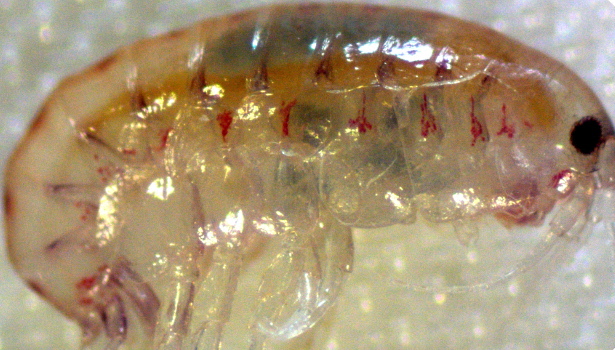In this post, Patrick Baudy reports on their recent paper on reproductive effects of fungicides in shredders.

Female Hyalella azteca carrying fertilized embryos (shaded spot) in its brood pouch (photo by P. Baudy)
Due to preventive and repetitive use of fungicides in agriculture, organisms inhabiting stream ecosystems may be chronically exposed towards these substances. Accordingly, leaf-shredding macroinvertebrates, which play a key role in the ecosystem function of leaf litter breakdown, show a reduced physiological fitness and functional performance when exposed to field-relevant fungicide concentrations. So far fungicide effects on the reproduction of these animals have received little attention, although this process represents a critical determinant for shredders’ abundance and thus their functional performance at the population level.
In order to address this issue, we conducted a 56-days lasting partial life-cycle bioassay exposing the amphipod model shredder Hyalella azteca towards field-relevant sum concentrations of 5 and 25 µg/L of a five-component fungicide mixture (i.e., azoxystrobin, carbendazim, cyprodinil, quinoxyfen, and tebuconazole). To investigate whether potential effects on reproduction could be linked to stress-induced energetic imbalances, inter alia the animals’ food utilization and survival were quantified in addition to variables related to reproduction.
Our results reveal that fungicide-exposed amphipods’ feces production was reduced, which points to an increased food utilization. This, in turn, indicates additional stress-induced energy requirements as a consequence of detoxification and repair mechanisms (e.g., an increased production of enzymes involved in the biotransformation of xenobiotics). However, despite this compensatory mechanism the animals were not able to counterbalance the increased energy demands: survival was decreased and time to first offspring was increased in both fungicide treatments, while offspring production was almost absent in the 25-µg/L treatment.
In the field, such effects may result in a lower recruitment within fungicide-affected shredder populations, which may lead to lower abundances and thus a lower contribution to leaf litter breakdown. Ultimately this might have detrimental consequences for the associated food webs relying on resources (such as fine particulate organic matter) provided by shredders.
The paper was authored by Patrick Baudy, Jochen Zubrod, Marco Konschak, Ralf Schulz, and Mirco Bundschuh and published in Environmental Pollution.
